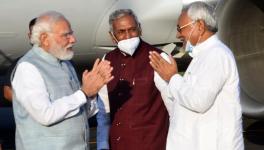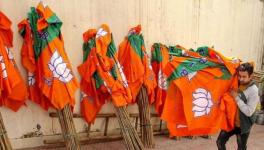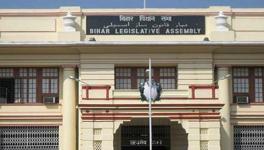Bihar: Reducing Lightning-Related Deaths a new Challenge
Representational use only.Image Courtesy: Wikimedia Commons
Patna: Climate change-induced extreme weather events like increasing lightning strikes killed more than 1100 people, mostly poor, in Bihar, in the last three years. As per the officials of the state disaster management department (DMD), the increase in deaths in lightning incidents has emerged as a new challenge despite a massive campaign to create awareness to reduce casualties.
According to the DMD's figures, 375 people were killed by lightning strikes in the state in 2022. Of this, 104 people died in July, 96 in September and 64 in June.
The possibility of more lightning strikes is less in the coming days because lightning strikes are usually reported during the June-September-October monsoon season in the state.
As per official figures, in 2021, 280 people were killed by lightning in Bihar. Lightning killed 459 people in Bihar in 2020, 253 in 2019, 139 in 2018,180 in 2017, and 114 in 2016. Lightning strikes killed 1,800 people in the last seven years in the state. It may be less than the floods, but one of the highest casualties due to natural calamities, much more than heat and cold waves. The State government has been providing compensation of Rs 4 lakh to each of the families of the lightning victims.
The DMD's figures pointed out that most deaths were due to lightning strikes reported in rural areas compared to urban areas. It further noted that landless farm labourers, poor farmers and cattle grazers form the majority of victims of lightning strikes.
"This was confirmed by the official data of 2019, 2020, and 2021 as nearly 86% of victims were landless farm labourers, poor farmers and cattle grazers."
Taking serious note of the increasing lightning incidents and deaths, the local India Meteorological Department (IMD) has been doing a study on it.
"Increasing lightning incidents in Bihar is a matter of study, and a team of our scientists has been doing it. They will come out with specific data, trends and other issues related to increasing lightning," Sanjay Kumar, a scientist at IMD here, told NewsClick.
Ashish Kumar, another scientist at IMD here, said as per their research study so far, it was found that most lightning incidents were reported in districts on both sides of the adjoining river Ganga.
"During pre-monsoon season in April -May -June, hot westerly winds spread over most of the districts and when monsoon entered the state with moisture-laden easterly winds, it collided that resulted in thunderstorms and lightning.
Abdus Sattar, senior scientist at the Centre for Advanced Studies on Climate Change, Rajendra Prasad Central Agricultural University, Pusa, Samastipur district, told NewsClick that in recent years, the state is witnessing an increase in incidents of lightning strikes; this may be due to the direct impact of climate change. Many studies worldwide pointed out that increasing lightning resulted from global warming.
"We are also studying the trend and will come out with actual causes behind it."
Bihar Chief Minister Nitish Kumar repeatedly directed concerned officials to focus work in rural areas to alarm people and create awareness to manage increasing lightning cases that result in deaths of people.
Contrary to the State government's claim of a massive awareness campaign to alert people about how to save them from lightning strikes, ground reality indicates something else. A few years ago, the government launched a mobile app, 'Indravajra', a much-hyped early warning system for lightning strikes. Still, government agencies have failed to reach out to the most vulnerable section in danger of being struck by lightning.
The app is one of the measures the DMD took to warn people ahead of lightning strikes. DMD officials said the app was helpful as it gives alerts for lightning in the form of alarm bells at least half an hour in advance within a radius of 20 kilometres. The mobile app Indravajra can only be downloaded on smartphones. As a result, poor farmers, farm labourers and cattle grazers do not have the means to access it. It was evident that to date, 1.25 lakh smartphone users have downloaded the app so far, mostly in urban areas.
But the department forgot to consider that poor farmers, farm labourers and cattle grazers, who form the majority of victims of lightning strikes, do not use their smartphones when outside their houses. The department officials admitted that most of the victims were at work in paddy fields or grass fields. They were neither informed, alerted, nor advised not to venture out of their homes.
Besides, the department has installed an early warning system at eight places with the help of US-based Earth Networks. This is expected to provide an advance warning about lightning at particular places.
The DMD, during monsoon, has been advising people to avoid going outside, particularly in the field, considering the forecast for storms and rain issued by the IMD. The DMD had issued an advertisement in local Hindi dailies on what to do and not to do to protect oneself from lightning strikes. In its advertisement, the department also urged people to download the mobile app 'Indravajra' to access predictions for thunderbolts in their area.
Get the latest reports & analysis with people's perspective on Protests, movements & deep analytical videos, discussions of the current affairs in your Telegram app. Subscribe to NewsClick's Telegram channel & get Real-Time updates on stories, as they get published on our website.





















